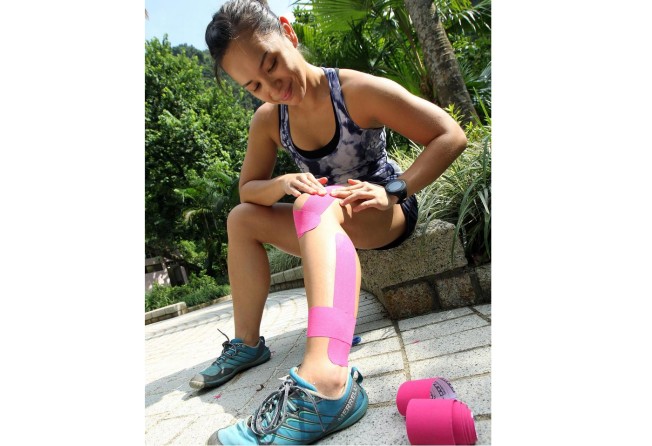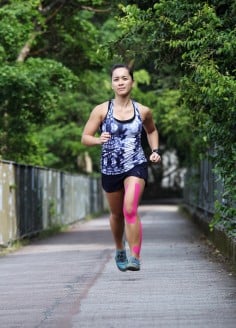Athletes swear by the healing properties of kinesio tape
There is no scientific evidence to support it, but athletes swear by the healing properties of kinesio tape

Taking part in the 100-kilometre Oxfam Trailwalker was not an unthinkable challenge for Lory May Martin four years ago, except for one detail: at the time, eight months from race day, she'd never run more than a handful of kilometres at a go.
When she started training for the ultra-endurance event, "that's when the injuries started", says Martin, 33, a personal trainer. To manage her injuries, her sister, a physiotherapist, started using "kinesio tape" (kinesiology tape) - a brightly coloured elasticated cotton sticky tape - on Martin's battered body. The results were instant, Martin says, and she could continue training.
"I now use it for everything - my ankle, my knees," she says.
Captivated by the tape's seemingly magical properties, she has since gone on to study taping methods and teaches fellow running junkies how to tape their injuries.
While every day athletes from runners to tennis players to gym rats are just catching on to this method of sports injury treatment, elite athletes started sporting the brightly coloured tape at the 2004 Athens Olympics.
It adorned the right forearm of Paraguayan javelin thrower and model Leryn Franco, and the sore shoulder of American beach volleyball champion Kerri Walsh Jennings.
At London 2012, it was a common sight: on everything from rumps to bare chests and even cheekbones.
In fact, Kinesio Tex tape - to give it its original name - was developed more than three decades ago by Japanese chiropractor Dr Kenzo Kase, albeit in less conspicuous colours.
In Hong Kong, some hospitals such as Pamela Youde Nethersole Eastern Hospital and the David Trench Rehabilitation Centre use it.
Despite the widespread use and enthusiasm, several scientific studies have failed to find evidence of the tape's beneficial claims.
"I definitely don't think it's a miracle," says Dr Simon Yeung, associate professor at Polytechnic University's department of rehabilitation sciences. But Yeung believes that the tape does have a subtle, yet powerful, effect - if applied correctly. "Skill is very important; you need to know where the muscles are in order to tape properly," he says.
While the goal of traditional taping is to restrict movement, kinesio taping aims for the opposite: to promote mobility, which in turn improves circulation, reduces pain and speeds healing, says Yeung.
Other claimed benefits include correcting structural problems and affecting pain sensors under the skin to activate the body's own healing mechanisms.
Correctly applied, the tape works by gently lifting the layer of skin - which is connected to muscle tissue and fascia - so that blood and other bodily fluids can move more freely, allowing for increased muscle movement and taking pressure off swollen, injured muscles.
A study published in 2010 in Clinical Rheumatology compared the efficacy of kinesio tape and physical therapy in 55 patients with shoulder impingement syndrome. Over two weeks, about half the patients were treated three times with kinesio tape every three days, and the other half given daily physical therapy (such as ultrasound, transcutaneous electrical nerve stimulation and hot packs).
All patients also received a home exercise programme for strengthening, stretching and relaxing the shoulder muscles. Based on the patients' self-rated pain scores, kinesio tape was found to be more effective than the local modalities for the first week and was similarly effective during the second week of treatment. The researchers concluded: "Kinesio taping may be an alternative option in the treatment of shoulder impingement syndrome, especially when an immediate effect is needed."
Benefits, if any, are only short lived, according to a study in the Physician and Sports Medicine Journal in November 2012. Reviewing many published studies in the field, the researchers found the tape has no long-term benefits, but may play a small role in improving strength and range of motion in some injuries. On the whole, they found little quality evidence to support the use of kinesio tape following musculoskeletal injury.

Triathlete Jane McNae, who has suffered from plantar fasciitis (pain at the sole of the foot) for the past 18 months, says kinesio tape did a good job initially of supporting her foot's high arch. After six months, however, the ankle support is there, but the effect is not substantial, she says. Besides, she finds that the tape, which is supposed to last for up to five days, loses its stickiness in water.
Yeung and his colleague Ella Yeung have been holding kinesio taping courses for physiotherapists since 2006, and have trained more than 400 physiotherapists in Hong Kong. To complete the course, physiotherapists undertake 24 hours of study over three days.
A user who is untrained in physiology and anatomy might not apply the tape in the right way, and miss the benefits.
"Kinesio tape is only effective if it is applied in the right position, with the correct tension to get the desired effect," says physiotherapist Chris Sherer from Hong Kong Sports and Spinal Physiotherapy Centre, who tapes several of Hong Kong's elite rugby players.
"My advice is that if you want to use it, it's best to see a trained professional who can apply it for you, and teach you how to apply it correctly yourself outside of the clinic."
Perhaps the greatest support for the tape is the anecdotal evidence from the many athletes who swear by it, including marathoner Paula Radcliffe and sprinter Michael Johnson.
In an opinion piece recently published in the Journal of Manual Therapy, Italian researcher Stefano Vercelli states that the strong placebo effect of taping may be its greatest asset.
Keep in mind that not all tapes are created equal. Sherer is a fan of KT Tape, while Yeung only uses Kinesio (trade names). There are several other brands on the market, including Rock Tape and Mueller, both of which are also available in Hong Kong. Each tape has slightly different properties.
But the good news is that even if you get it wrong, it won't do you any harm. "I use it all the time," says former Hong Kong national rugby player Fiona Foxon, 29, who recently used the tape in a triathlon in the Philippines. "Even if research says otherwise, who cares? I felt better," she says.